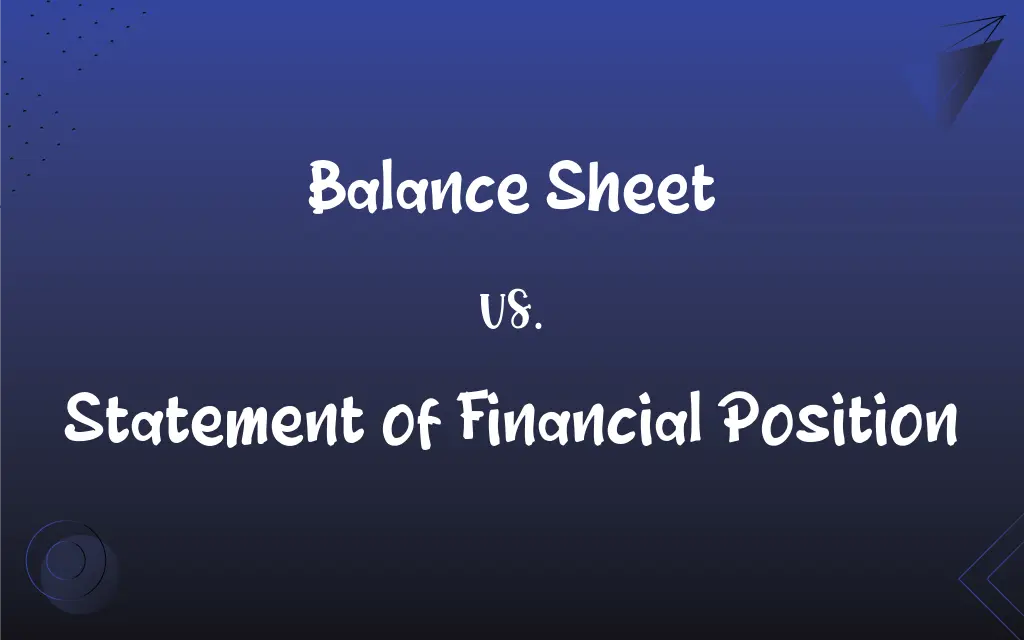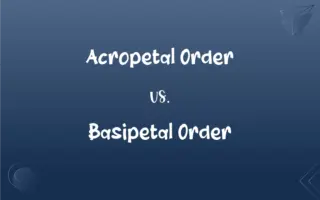Balance Sheet vs. Statement of Financial Position: What's the Difference?
Edited by Aimie Carlson || By Harlon Moss || Published on November 4, 2024
The balance sheet and statement of financial position are essentially the same, both showing a company's assets, liabilities, and equity at a specific point in time.

Key Differences
The terms balance sheet and statement of financial position are often used interchangeably in financial accounting to represent a financial statement that outlines a company's assets, liabilities, and equity at a particular point in time. However, the preference for one term over the other can depend on the accounting framework or standard being followed. For instance, IFRS (International Financial Reporting Standards) users may prefer 'statement of financial position', while those adhering to GAAP (Generally Accepted Accounting Principles) in the United States might use 'balance sheet'.
Both the balance sheet and the statement of financial position serve the fundamental purpose of providing stakeholders with a snapshot of what the company owns and owes, as well as the amount invested by shareholders. They are crucial for assessing the financial health and liquidity of a business. The balance sheet follows a simple equation: Assets = Liabilities + Equity, which is mirrored in the statement of financial position. This equation underpins the double-entry bookkeeping system that ensures every financial transaction affects both sides of the statement equally, maintaining balance.
The balance sheet is a term more traditionally used, the statement of financial position might be seen as a more modern or comprehensive description that reflects the company's financial status. Regardless of the terminology, both documents categorize assets into current and non-current (or long-term) and do the same for liabilities, providing insights into the company’s operational efficiency, financial stability, and capacity for growth or investment.
The layout and presentation of the balance sheet versus the statement of financial position can vary slightly depending on the reporting requirements of the accounting standards under which they are prepared. However, the core components remain the same: detailing the types and values of assets, liabilities, and equity. This includes cash and cash equivalents, accounts receivable, inventory for assets, and accounts payable, loans, and shareholder equity, among others.
Whether it is called a balance sheet or a statement of financial position, this financial statement is indispensable for users of financial information, including investors, creditors, and management, to make informed decisions regarding the company. It reflects the financial outcomes of business activities and strategic decisions, providing a basis for evaluating past performance and planning future operations.
ADVERTISEMENT
Comparison Chart
Terminology
Traditionally used in GAAP
Preferred in IFRS
Purpose
Shows assets, liabilities, and equity
Same as balance sheet
Framework Preference
Common in U.S. GAAP
Common in international contexts under IFRS
Modern Usage
Considered more traditional
Seen as more contemporary
Financial Snapshot
At a specific point in time
Identical purpose, different nomenclature
ADVERTISEMENT
Balance Sheet and Statement of Financial Position Definitions
Balance Sheet
Used to assess a company's liquidity and financial stability.
The balance sheet indicates our ability to cover short-term obligations.
Statement of Financial Position
Basis for evaluating financial flexibility and risk.
Our statement of financial position demonstrates increased liquidity.
Balance Sheet
Provides insights into the capital structure.
The balance sheet shows a healthy equity to debt ratio, signaling strength.
Statement of Financial Position
Reflects outcomes of business strategies on financial health.
Strategic investments have positively impacted our statement of financial position.
Balance Sheet
A financial statement detailing a company's assets, liabilities, and equity.
The balance sheet from December shows a strong increase in assets.
Statement of Financial Position
Critical for investor and creditor decision making.
Investors scrutinize the statement of financial position for investment safety.
Balance Sheet
Reflects the financial position at a specific moment.
Analyzing the balance sheet helps us understand our financial health.
Statement of Financial Position
An overview of a company's financial status including assets, liabilities, and equity.
The statement of financial position reveals a solid foundation for expansion.
Balance Sheet
Essential for strategic financial planning and analysis.
Our CFO uses the balance sheet for making informed investment decisions.
Statement of Financial Position
Captures the economic resources controlled by the company.
This year's statement of financial position shows improved asset management.
FAQs
Are balance sheet and statement of financial position the same?
Yes, they essentially serve the same purpose but the terminology may vary based on the accounting standard used.
Why is a balance sheet important?
It provides a snapshot of a company’s financial health, necessary for decision-making by stakeholders.
What does a statement of financial position represent?
It represents a company's financial status, detailing assets, liabilities, and equity, similar to a balance sheet.
How often is a balance sheet prepared?
Typically, it’s prepared at the end of an accounting period; quarterly or annually.
What’s the key difference in terminology between GAAP and IFRS?
GAAP often uses "balance sheet," while IFRS prefers "statement of financial position."
Does a balance sheet show company performance?
Indirectly, by showing the financial status at a point in time, but not performance over a period like an income statement.
What is a balance sheet?
A financial statement that shows a company's assets, liabilities, and equity at a specific date.
Can the statement of financial position help in assessing liquidity?
Yes, it details current assets and liabilities, helping assess liquidity.
Can a statement of financial position change daily?
Theoretically yes, as daily transactions affect a company’s financial status, but it’s usually updated periodically.
Are intangible assets listed on the balance sheet?
Yes, intangible assets like patents are listed under non-current assets.
What role does the statement of financial position play in strategic planning?
It aids in assessing financial stability and planning for future investments or debt reduction.
What is the formula underlying a balance sheet?
Assets = Liabilities + Equity.
How do current and non-current classifications differ on these statements?
Current items are due within one year; non-current items are long-term.
What is the significance of the order of listing assets and liabilities?
Assets and liabilities are typically listed in order of liquidity or maturity.
Why might a company have a strong balance sheet?
A strong balance sheet typically indicates good liquidity, manageable debt, and solid equity, suggesting financial health.
Is shareholder equity always positive on a balance sheet?
Ideally, yes, but it can be negative in cases where a company has sustained losses.
How does equity appear on the statement of financial position?
Equity is shown as the difference between total assets and total liabilities.
What information do creditors look for in a statement of financial position?
Creditors look for information on liquidity and debt levels to assess risk.
How do balance sheets relate to other financial statements?
They are interconnected; for example, net income from the income statement affects equity on the balance sheet.
Can these financial statements predict future performance?
They provide a basis for analysis but cannot predict future performance without other information.
About Author
Written by
Harlon MossHarlon is a seasoned quality moderator and accomplished content writer for Difference Wiki. An alumnus of the prestigious University of California, he earned his degree in Computer Science. Leveraging his academic background, Harlon brings a meticulous and informed perspective to his work, ensuring content accuracy and excellence.
Edited by
Aimie CarlsonAimie Carlson, holding a master's degree in English literature, is a fervent English language enthusiast. She lends her writing talents to Difference Wiki, a prominent website that specializes in comparisons, offering readers insightful analyses that both captivate and inform.






































































